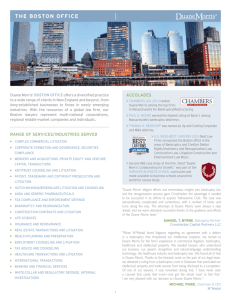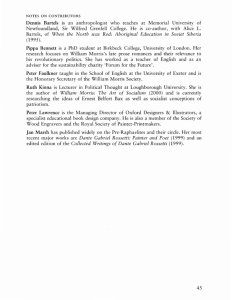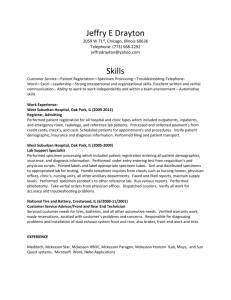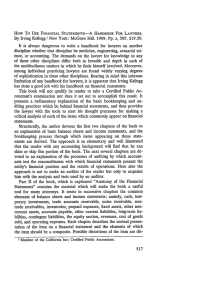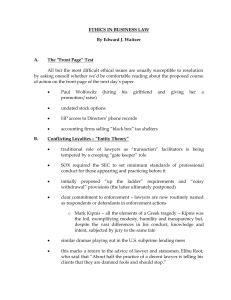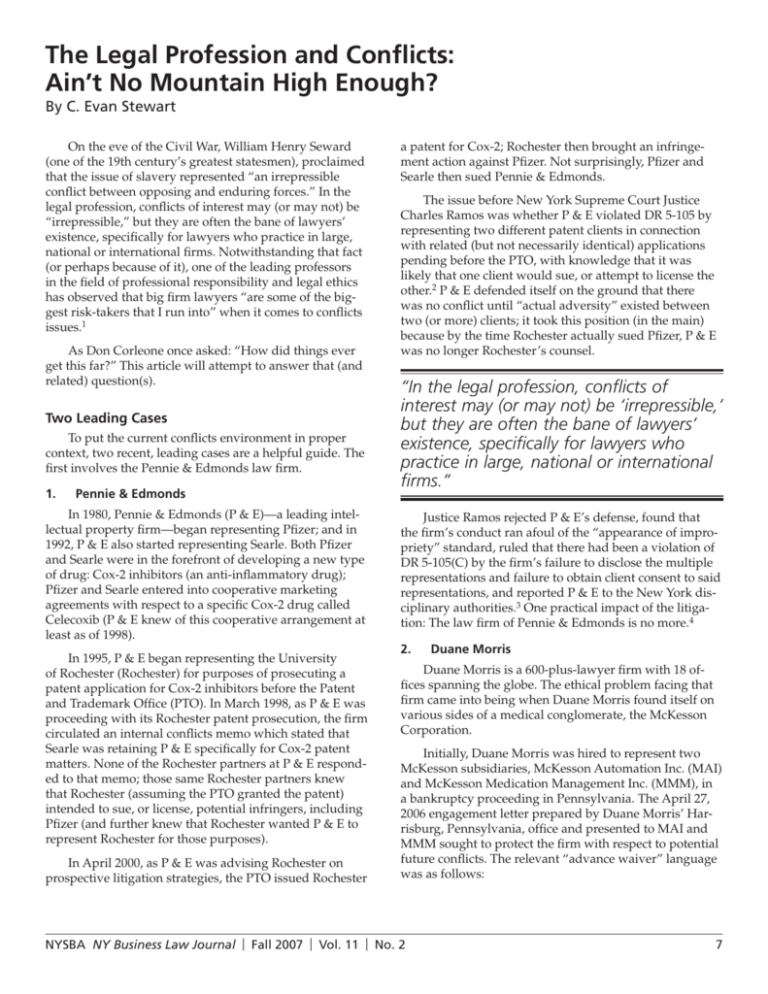
The Legal Profession and Conflicts:
Ain’t No Mountain High Enough?
By C. Evan Stewart
On the eve of the Civil War, William Henry Seward
(one of the 19th century’s greatest statesmen), proclaimed
that the issue of slavery represented “an irrepressible
conflict between opposing and enduring forces.” In the
legal profession, conflicts of interest may (or may not) be
“irrepressible,” but they are often the bane of lawyers’
existence, specifically for lawyers who practice in large,
national or international firms. Notwithstanding that fact
(or perhaps because of it), one of the leading professors
in the field of professional responsibility and legal ethics
has observed that big firm lawyers “are some of the biggest risk-takers that I run into” when it comes to conflicts
issues.1
As Don Corleone once asked: “How did things ever
get this far?” This article will attempt to answer that (and
related) question(s).
Two Leading Cases
To put the current conflicts environment in proper
context, two recent, leading cases are a helpful guide. The
first involves the Pennie & Edmonds law firm.
1.
Pennie & Edmonds
In 1980, Pennie & Edmonds (P & E)—a leading intellectual property firm—began representing Pfizer; and in
1992, P & E also started representing Searle. Both Pfizer
and Searle were in the forefront of developing a new type
of drug: Cox-2 inhibitors (an anti-inflammatory drug);
Pfizer and Searle entered into cooperative marketing
agreements with respect to a specific Cox-2 drug called
Celecoxib (P & E knew of this cooperative arrangement at
least as of 1998).
In 1995, P & E began representing the University
of Rochester (Rochester) for purposes of prosecuting a
patent application for Cox-2 inhibitors before the Patent
and Trademark Office (PTO). In March 1998, as P & E was
proceeding with its Rochester patent prosecution, the firm
circulated an internal conflicts memo which stated that
Searle was retaining P & E specifically for Cox-2 patent
matters. None of the Rochester partners at P & E responded to that memo; those same Rochester partners knew
that Rochester (assuming the PTO granted the patent)
intended to sue, or license, potential infringers, including
Pfizer (and further knew that Rochester wanted P & E to
represent Rochester for those purposes).
In April 2000, as P & E was advising Rochester on
prospective litigation strategies, the PTO issued Rochester
a patent for Cox-2; Rochester then brought an infringement action against Pfizer. Not surprisingly, Pfizer and
Searle then sued Pennie & Edmonds.
The issue before New York Supreme Court Justice
Charles Ramos was whether P & E violated DR 5-105 by
representing two different patent clients in connection
with related (but not necessarily identical) applications
pending before the PTO, with knowledge that it was
likely that one client would sue, or attempt to license the
other.2 P & E defended itself on the ground that there
was no conflict until “actual adversity” existed between
two (or more) clients; it took this position (in the main)
because by the time Rochester actually sued Pfizer, P & E
was no longer Rochester’s counsel.
“In the legal profession, conflicts of
interest may (or may not) be ‘irrepressible,’
but they are often the bane of lawyers’
existence, specifically for lawyers who
practice in large, national or international
firms.”
Justice Ramos rejected P & E’s defense, found that
the firm’s conduct ran afoul of the “appearance of impropriety” standard, ruled that there had been a violation of
DR 5-105(C) by the firm’s failure to disclose the multiple
representations and failure to obtain client consent to said
representations, and reported P & E to the New York disciplinary authorities.3 One practical impact of the litigation: The law firm of Pennie & Edmonds is no more.4
2.
Duane Morris
Duane Morris is a 600-plus-lawyer firm with 18 offices spanning the globe. The ethical problem facing that
firm came into being when Duane Morris found itself on
various sides of a medical conglomerate, the McKesson
Corporation.
Initially, Duane Morris was hired to represent two
McKesson subsidiaries, McKesson Automation Inc. (MAI)
and McKesson Medication Management Inc. (MMM), in
a bankruptcy proceeding in Pennsylvania. The April 27,
2006 engagement letter prepared by Duane Morris’ Harrisburg, Pennsylvania, office and presented to MAI and
MMM sought to protect the firm with respect to potential
future conflicts. The relevant “advance waiver” language
was as follows:
NYSBA NY Business Law Journal | Fall 2007 | Vol. 11 | No. 2
7
Given the scope of our business and
the scope of our client representations
through our various offices in the United
States and abroad, it is possible that
some of our present or future clients
will have matters adverse to McKesson
while we are representing McKesson.
We understand that McKesson has no
objection to our representation of parties
with interests adverse to McKesson and
waives any actual or potential conflict of
interest as long as those other engagements are not substantially related to our
services to McKesson.
under Georgia’s rules governing lawyers’ professional
conduct. Steven Krane, a partner at New York’s Proskauer Rose and the current chair of the ABA’s Standing
Committee on Ethics and Professional Responsibility,
testified “at great length” for Duane Morris, contending
that Pennsylvania law applied to the MAI/MMM engagement letter, that Pennsylvania’s attorney rules permitted a
waiver of this kind, and that large conglomerates such as
McKesson could not reasonably expect law firms to have
a single engagement with one small part of the entity
govern its ability to take on unrelated matters for other
corporate family members.
We agree, however, that McKesson’s
consent to, and waiver of, such representation shall not apply in any instance
where, as a result of our representation
of McKesson, we have obtained proprietary or other confidential information
of a non-public nature, that, if known
to such other client, could be used in
any such other matter by such client
to McKesson’s material disadvantage
or potential material disadvantage. By
agreeing to this waiver of any claim of
conflicts as to matters unrelated to the
subject matter of our services to McKesson, McKesson also agrees that we are
not obligated to notify McKesson when
we undertake such a matter that may be
adverse to McKesson.
A few months later, Duane Morris’ Atlanta office was
hired to represent two individuals in an arbitration proceeding against a different McKesson subsidiary, McKesson Information Systems (MIS). As soon as MIS learned
of opposing counsel, it wrote Duane Morris, demanding
that the firm withdraw. Duane Morris refused, citing the
advance waiver language of the Pennsylvania retainer
letter which allowed for the firm to represent clients in
cases adverse to McKesson on matters not substantially
related to the businesses of MAI and MMM. Duane
Morris also said that if McKesson insisted on its conflicts
position, the firm would withdraw from representing
MAI and MMM in Pennsylvania.
McKesson’s response? It sued Duane Morris in
Georgia state court, claiming that the firm’s threat to
withdraw in Pennsylvania’s constituted “extortion,” and
seeking Duane Morris’ disqualification from the MIS
litigation. At a hearing at the end of October 2006, the
Georgia court was presented with a battle of experts. For
McKesson, Professor Clark Cunningham of the Georgia State College of Law testified that Duane Morris’
advance waiver provisions were impermissibly broad
8
After noting that Georgia’s and Pennsylvania’s advance waiver rules “are very similar,” the Georgia court
came down on the side of Professor Cunningham and
ruled that Georgia law was applicable to the dispute at
hand.5 Georgia’s Rule 1.7(a) reads, in pertinent part, “A
lawyer shall not represent or continue to represent a client
if there is a significant risk that the lawyer’s own interests
or the lawyer’s duties to another client, a former client,
or a third person will materially and adversely affect the
representation of the client. . . .”6 To Duane Morris’ contention that their conduct was not improper because the
matters were unrelated, the court cited to Comment 8 of
Rule 1.7, which says that a lawyer cannot act as an advocate against a client the lawyer represents in another matter, even if the other matter is wholly unrelated. As to the
written consensual waiver contemplated by Rule 1.7(b),
the court ruled that the MAI/MMM engagement letter
was “not a knowing waiver that identifies the specific
adverse clients and details of adverse representations.”7
In light of those determinations, Duane Morris was ruled
to be disqualified in its case against MIS.8
Advance Waivers
As the Duane Morris litigation makes evident, the
issue of advance waivers can be a pretty sticky wicket.9
And yet, law firms regularly use language not dissimilar
to that which Duane Morris put in its McKesson retainer
letter.10 So what gives?
Under the revised ABA Model Rules (2002), advance
waivers can in fact work—so long as the waiving client gives “informed” consent (Rule 1.7). But what is
“informed” consent? According to ABA Comment 22 to
Rule 1.7, in order to give such consent a waiving client
must “reasonably understand [] the material risk that the
waiver entails.” Such an understanding may be gleaned,
inter alia, from: (i) a (more) detailed statement of the types
of future engagements that might be undertaken; (ii) a
(more) detailed statement of the “reasonably foreseeable adverse consequences” of said engagements; (iii)
if the “particular type of conflict” is one with which the
waiving client is familiar; (iv) if the waiving client is “an
experienced user of the legal services” at issue; (v) if the
NYSBA NY Business Law Journal | Fall 2007 | Vol. 11 | No. 2
waiving client is represented by the other counsel for
purposes of giving consent; and (vi) if the consent is limited to prospective engagements unrelated to the current
representation.11
• The prejudice the withdrawal or continued representation would cause the parties (including
whether continuing representation of one party
would give it an unfair advantage to the detriment
of the other party [this is the most important factor]);
The ABA’s “revised” Rule 1.7 (and Comment 22
thereto) constituted a shift toward being more embracing
of advance waivers. And just to make sure that shift was
crystal clear, the ABA issued ABA Opinion 05-436 (May
11, 2005), which both withdrew ABA Opinion 93-372 (a
more skeptical view of advance waivers) and endorsed
“open-ended” waivers where the waiving client is sophisticated or represented by counsel.12
Perhaps the Duane Morris court did not get the message; it is more likely that the language of the Duane
Morris engagement letter did not capture enough of the
factors set forth in Comment 22 to Rule 1.7.13 Other courts
do appear to be getting the message. Thus, where the
waiver has been explicit and the waiving client was sophisticated, for example, courts have shown an increased
appetite for approving these provisions.14
A “Hot Potato”
Not so long ago, the spelling of potato was a political
issue.15 Now, the concept of the “hot potato” has entered
the lexicon of legal ethics.
The “hot potato” rule stands for the salutary proposition that a lawyer may not drop one client in favor of
another client, “especially if it is in order to keep happy
a far more lucrative client.”16 Despite the broad prohibition of that rule, the legal profession has been quick (and
creative) in finding ways around it.
For example, there is a growing line of cases that
allows a lawyer to ethically drop one client in favor of another, if the “dropped” client can be characterized as an
“accommodation” client. In the securities litigation arising out of problems at the Rite Aid Corporation,17 outside
counsel to the corporation and the CEO determined after
an internal investigation that it could no longer defend
the interests of both clients and told the company that the
CEO (by now terminated) needed his own lawyer. The
court, on the CEO’s motion to disqualify his former firm,
deemed the CEO to be an accommodation client who had
impliedly consented to the outside counsel’s primary allegiance to the company.18
There is another line of cases, strongly encouraged
by bar groups, where courts have applied a flexible approach to “thrust upon” situations.19 Essentially, the view
is that the “hot potato” rule should not kick in where it
is not the lawyer who seeks to drop a client to pursue a
better client, but rather where the lawyer gets the conflict
“thrust upon” her (for example, by a corporate merger).
Factors to be used in applying this flexible approach
include:
• What caused the conflict to occur;
• Whether the conflict was created or is being used to
effect an advantage; and
• The costs and convenience to the party required to
retain new counsel.
Perhaps the most interesting take on the “hot potato”
rule has come from the Northern District of Ohio in Pioneer-Standard Electronics Inc. v. Cap Gemini America Inc.20
There, the New York–based firm of Shearman & Sterling
was representing Pioneer on a pending European Commission matter when Cap Gemini retained the firm to
defend it against Pioneer in an Ohio federal action. Shearman sought a waiver from Pioneer, but Pioneer refused
that request. Shearman then told Pioneer it was dropping
the company as a client.
When Pioneer moved to disqualify Shearman as Cap
Gemini’s counsel in Ohio on the ground that the law
firm’s professional judgment was likely to be “adversely
affected” by the multiple representations, Shearman’s
defense was that there was no such problem since it had
dropped Pioneer as a client before appearing in the Ohio
litigation. The court rejected Shearman’s position as being in violation of the “hot potato” rule—i.e., it could not
drop Pioneer as a client. At the same time, the court also
ruled that there was no reason why Shearman could not
represent both Cap Gemini in Ohio (against Pioneer) and
Pioneer in Europe “with equal vigor” and without violating client confidences to the detriment of the other.21
Corporate Affiliates and Subsidiaries
One area where the Duane Morris court might have
focused its attention (but did not) was on whether corporate affiliates and subsidiaries may be considered as
different entities for conflicts purposes. According to ABA
Opinion 95-390 (January 25, 1995), a lawyer representing
a corporate client “is not by that fact alone necessarily
barred from representation that is adverse to a corporate
affiliate of that client in an unrelated matter.” Put another
way (and according to 95-390), said lawyer for the corporate client may, under many/most circumstances, sue the
client’s wholly owned subsidiary without obtaining the
client’s informed consent.
Well, what is wrong with that? First off, as the vociferous dissents to 95-390 pointed out (the ABA committee split 6-4), this approach has a few flaws: (i) it seems
directly at odds with traditional notions of client loyalty;
NYSBA NY Business Law Journal | Fall 2007 | Vol. 11 | No. 2
9
Interestingly, the ABA’s MODEL RULES OF PROF’L CONDUCT and
the ALI’s RESTATEMENT (THIRD) OF THE LAW GOVERNING LAWYERS
(2000) (hereinafter “ALI’s RESTATEMENT”) do not provide for the
“appearance of impropriety” as an appropriate standard for
conflicts of interest. And most states have followed that approach.
See, e.g., Addam v. Super. Court, 10 Cal. Rptr. 3d 39, 42-43 (2004).
(ii) it exalts corporate form and structure over corporate
substance and reality; (iii) it makes it hard to understand
the distinction between direct and indirect economic
harm to the corporation; and (iv) it seems to be a trap for
non-Fortune 500 companies (i.e., those who just assume
lawyer loyalty and are without sufficient resources to
hire scores of in-house lawyers to protect against such
circumstances).22 Even more important is the fact that
any corporate lawyer proceeding in the fashion envisioned by the 95-390 majority (i.e., suing a subsidiary
without, at a minimum, consulting and getting consent
from the parent company) would likely be fired by the
company’s general counsel as soon as she discovered the
perfidious act of the outside lawyer.23
4.
A similar, if even more “egregious” case, recently involved Wilson
Elser Moskowitz Edelman & Dicker. See Ulico Casualty Co. v.
Wilson, Elser, Moskowitz, Edelman & Dicker, No. 602229/99, 2007
WL 2142299 (New York Sup. Ct. March 29, 2007). There, the court
granted partial summary judgment for liability insurer Ulico,
which sued its former law firm for breach of fiduciary duty by
participating in a scheme to transfer Ulico’s policy holders to
another insurer client of the firm’s. Citing DR 5-105, the court
ruled that the case involved “conduct by an attorney which
fostered the business interests and advanced the competitive
position of certain clients not over a former client but over a client
which the attorney was still representing.” Id. at *6. As a result,
the court (i) ordered the law firm to disgorge to Ulico $3.4 million
in fees paid by Ulico, and (ii) allowed Ulico to proceed to trial on
other damage claims totaling more than $100 million. Id. at *15.
5.
The court looked to Georgia’s Rule 8.5, by which, inter alia, the
law of the jurisdiction in which the lawyer’s conduct took place
governs. Query whether Duane Morris made the right tactical
decision in choosing a New York based lawyer (regardless of
expertise) to face off in a Georgia state court against a local
Georgia professor on this issue.
6.
GA RULES OF PROF’L CONDUCT R. 1.7(a).
7.
The court’s cited authority for its ultimate holding was Worldspan,
L.P. v. Sabre Group Holdings, Inc., 5 F. Supp. 2d 1356 (N.D. Ga. 1998)
and Snapping Shoals Electric Membership Corp. v. RLI Insurance Corp.,
No. 1:05 CV 1714-GET, 2006 WL 1877078 (N.D. Ga. 2006).
8.
Interestingly, on March 6, 2007, the trial judge lifted the bar on
Duane Morris representing parties adverse to MIS because its
representation of MIA and MMM in the bankruptcy proceeding
had ended in a proper manner at the conclusion of that
proceeding. As such, Rule 1.9, instead of Rule 1.7, was the nowapplicable ethics rule; the court, emphasizing the right of clients
to choose counsel, then allowed Duane Morris to re-institute its
representation. See ABA & BNA, ABA/BNA LAWYERS’ MANUAL ON
PROFESSIONAL CONDUCT 132-33 (2007).
The legal profession thirty-two years later seems
a very different place in many respects. The organized
bar’s imaginative, multi-headed attempts to circumvent
or evade existing conflicts of interest rules (as set forth
above) appear to be motivated primarily by the economic
needs and pressures of an increasingly competitive business. Where this ride will end, who knows. Until then,
as Bette Davis once emoted: “Fasten your seat belts, it is
going to be a bumpy night!”
9.
Compare Westinghouse Elec. Corp. v. Gulf Oil Corp., 558 F.2d 221
(7th Cir. 1978) with Interstate Prop. v. Pyramid Co., 547 F. Supp. 178
(S.D.N.Y. 1982); Unified Sewage Agency of Washington County v. Jelco
Co., 646 F. 2d 1339 (9th Cir. 1981).
10.
See Richard W. Painter, Advance Waiver of Conflicts, 13 GEO. J. LEGAL
ETHICS 289 (2000).
11.
MODEL RULES OF PROF’L CONDUCT R. 1.7 cmt. 22. ALI’s RESTATEMENT
is generally in accord with the Model Rule, although it does say
that advance waivers are subject to “special scrutiny.” The bar in
the District of Columbia has long been favorably disposed toward
advance waivers. See D.C. Legal Ethics Comm., Op. 309 (Sept. 20,
2001). See also N.Y.C., Op. 2006-1 (Feb. 17, 2006).
Endnotes
12.
ABA Comm. on Ethics and Prof’l Responsibility, Formal Op.
05-436. Op. 93-372 warned that “no lawyer can rely with ethical
certainty on prospective waiver. . . .”
13.
See also Concat LP v. Unilever, PLC, 350 F. Supp. 2d 796 (N.D. Cal.
2004).
14.
See Visa U.S.A., Inc. v. First Data Corp., 241 F. Supp 2d 1100 (N.D.
Cal. 2003); General Cigar Holdings v. Altadis, 144 F. Supp. 2d 1334
(S.D. Fla. 2001); St. Barnabas Hosp. v. New York City Health & Hosp.
Corp., 7 A.D.3d 83, 775 N.Y.S.2d 9 (1st Dep’t 2004). Even with
this shift, many lawyers experienced in this area continue to be
uncertain how uniformly supportive courts will be to advance
waivers. See ABA & BNA, ABA/BNA LAWYERS’ MANUAL ON
PROFESSIONAL CONDUCT, APRL SPEAKERS AND AUDIENCE DEBATE
Courts traditionally have not embraced the view or
rationale of 95-390’s majority.24 But increasingly courts
are starting to experiment in this area, especially if a subsidiary can be shown to be independent of another corporate entity, so that the transmittal of client confidences
and other information would not be presumed.25 Suffice
it to say that predicting how this niche of the conflicts
market will play out would be problematic, at best.
Conclusion
In his seminal article in 1975 on lawyers and their
role in the adversarial system, Simon Rifkind passionately expressed his faith in that system, and in the lawyer’s
singular duty of client loyalty—to represent clients’
interests as zealously as legally permissible.26 To the extent conflicts of interest played a role in Judge Rifkind’s
article, it was to take strenuous issue with the notion that
lawyers might have divided loyalties between clients and
non-clients (and/or the general public).
1.
Karen Donovan, When Big Law Firms Trip Over Their Own Clients,
N.Y. TIMES, October 3, 2004, at B5.
2.
The Lawyer’s Code of Prof’l Responsibility, DR 5-105 (hereinafter
“Code”); MODEL RULES OF PROF’L CONDUCT R. 1.7.
3.
Justice Ramos’ decision, rendered on July 14, 2004, seems actually
quite restrained, finding only the “appearance of impropriety”
and a violation of DR 5-105(C). Given the clear and predictable
adversity of P & E’s multiple clients, DR 5-105(A) (“A lawyer shall
decline proferred employment . . . if it would be likely to involve
the lawyer in representing differing interests. . . .”) would appear
to have been the more appropriate ethical rule.
10
NYSBA NY Business Law Journal | Fall 2007 | Vol. 11 | No. 2
POSSIBILITY OF MODEL ADVANCE WAIVER FORM 96 (February 23,
2005) (“Advance consents are uniformly being used in large law
firms, even though lawyers are doubtful that they’ll hold up.”
Comments of Diane Karpman).
15.
During the administration of Bush 41, then Vice President Dan
Quayle got into hot water when he told a school child how to spell
“potatoe”!
16.
Picker Int’l, Inc. v. Varian Assoc., Inc., 670 F. Supp. 1363, 1365 (N.D.
Ohio 1987), aff’d, 869 F.2d 578 (6th Cir. 1989); Santacroce v. Neff, 134
F. Supp. 2d 366 (D.N.J. 2001); Argue v. David Davis Enter, Inc., No.
Civ.A. 02-9521, 2004 WL 2480836 (E.D.Pa. Nov. 4, 2004).
17.
See In re Rite Aid Corp. Sec. Litig., 139 F. Supp. 649 (E.D. Pa. 2001).
18.
See also Universal City Studios, Inc. v. Reimerde, 98 F. Supp. 2d
449 (S.D.N.Y. 2000) (court allowed adverse representation to
accommodation client, notwithstanding the affirmance of the
“hot potato” rule). And while ALI’s RESTATEMENT endorses the
concept of an accommodation client, not all commentators are
enthusiastic. See Douglas R. Richmond, Accommodation Clients, 35
AKRON L. REV. 80 (2001) (critical of creating a new breed of client
that is unnecessary, confusing, and imprudent).
19.
See Argue v. David Davis Enter. Inc., No. Civ.A. 02-9521, 2004 WL
2480836 (E.D. Pa. Nov. 4, 2004).; Univ. of Rochester v. G.D. Searle &
Co., No. 00-CV-6161L B., 2000 WL 1922271 (W.D.N.Y. 2000); N.Y.C.,
Op. 2005-5 (June 2005); D.C. Legal Ethics Comm., Op. 272 (May
21, 1997). ALI’s RESTATEMENT also recognizes the “thrust upon”
conflict exception to the “hot potato” rule.
20.
No. 1:01CV2185, 2002 WL 553460 (N.D. Ohio 2002).
21.
The court determined that (in Ohio, at least) there “is not a per
se rule against an attorney representing clients adverse to each
other.” Id.
22.
In one of the dissents, a devastating attack on the majority’s view
used Ford Motor Company’s structure (it would be okay to sue
Jaguar, a subsidiary—this would cause only an “indirect” harm;
it would not be okay to sue Escort, a division—this would cause a
“direct” harm) to highlight the highly dubious logic of points (ii)
and (iii). ABA Comm. on Ethics and Prof’l Responsibility, Formal
Op. 95-390.
23.
The 95-390 majority did point out that “as a matter of prudence
and good practice,” it would in fact make sense to check with the
client prior to taking on a representation adverse to a corporate
affiliate. ABA Comm. on Ethics and Prof’l Responsibility, Formal
Op. 95-390.
24.
See Strategen Dev. Corp. v. Heron Int’l N.V., 756 F. Supp. 789
(S.D.N.Y. 1991); Cincinnati Bell, Inc. v. Anixter Bros., No. C1-93-0871,
1994 WL 1877173 (S.D. Ohio 1994).
25.
See J.P. Morgan Chase Bank ex rel. Mahonia Ltd. v. Liberty Mut. Ins.
Co., 189 F. Supp. 2d 20 (S.D.N.Y. 2002); Goodlett v. Paul Revere
Life Ins. Co., No. C97-0089, 2000 WL 34027916 (N.D. Iowa 2000).
And some academic commentators have endorsed loosening up
the “unduly formalistic” approach to conflicts vis-à-vis complex
corporate structures. See Ronald D. Rotunda, Conflict Problems
When Representing Members of Corporate Families, 72 NOTRE DAME L.
REV. 655 (1997); T. Morgan, Suing Current Clients, 1 J. INST. STUDS.
LEG. ETHICS 8 (1994). See also MODEL RULES OF PROF’L CONDUCT R.
1.7, cmt. 34 (2004)..
26.
30 THE RECORD 534 (1975).
© 2007. All rights reserved.
Reprinted with permission from: NY Business Law Journal, Fall 2007, Vol. 11, No. 2, published
by the New York State Bar Association, One Elk Street, Albany, NY 12207.
NYSBA NY Business Law Journal | Fall 2007 | Vol. 11 | No. 2
11



